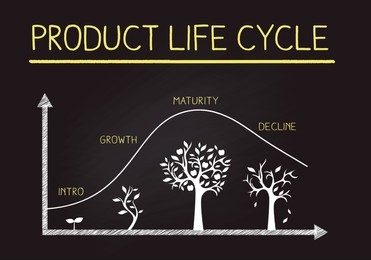The **product life cycle** is a concept that describes the stages a product goes through in the marketplace.
There are four stages in the product life cycle:
- **Introduction**: This is the stage when a product is first introduced to the market. Sales are typically low and grow slowly. The company profit is small (if any) as the product is new and untested. The introduction stage requires significant marketing efforts, as customers may be unwilling or unlikely to test the product.
- **Growth**: If the product continues to thrive and meet market needs, the product will enter the growth stage. In the growth stage, sales revenue usually grows exponentially from the take-off point. Economies of scale are realized as sales revenues increase faster than costs and production reach capacity. Competition in the growth stage is often fierce, as competitors introduce similar products.
- **Maturity**: Eventually, the market grows to capacity, and the sales growth of the product declines.
In this stage, price undercutting and increased promotional efforts are common as companies try to capture customers from competitors. Due to fierce competition, weaker competitors will eventually exit the marketplace – the shake-out. The strongest players in the market remain to saturate and dominate the stable market.
- **Decline**: In this stage, sales of the product decline as the market becomes saturated, and customers move on to newer and better products. Companies may choose to discontinue the product or sell it to another company.
Remember, the product life cycle is an ongoing process. Regularly review and update your analysis to ensure it remains relevant and effective.
What are some strategies for extending the product life cycle?
Extending the product life cycle is an important strategy for businesses to remain competitive. Here are some strategies that can be used to extend the product life cycle:
- **Product differentiation**: Make your product stand out from its competitors by highlighting the differences between it and other products.
- **Product improvement**: Continuously improve your product to meet the changing needs of your customers.
- **Market expansion**: Expand your market by targeting new customer segments or entering new geographic markets.
- **Price reduction**: Lower the price of your product to make it more attractive to customers.
- **Advertising**: Increase your advertising efforts to gain a new audience or remind the current audience of your product.
- **Adding value**: Add new features to your product to improve its functionality and value based on customer feedback.
- **Packaging redesign**: Change the packaging of your product to make it feel fresh and new.
Remember, extending the product life cycle is an ongoing process. Regularly review and update your strategy to ensure it remains relevant and effective.
Do not hesitate to ask us about solving problems in the 4 Stages of a Product Life Cycle. We may be the decisive step in your life. Contact us now, or follow up on our social media
Facebook, LinkedIn, Instagram



